NUR231: Case Study Response - Patient Condition and Treatment
VerifiedAdded on 2022/09/11
|10
|2613
|16
Case Study
AI Summary
This case study response for NUR231 analyzes a patient scenario involving asthma and Graves' disease, exploring various aspects of nursing care. The assignment begins by defining key medical terms like tachycardia, tachypnea, and angina, providing examples of observable data that could be charted to represent these signs and symptoms. It then outlines immediate actions for assessing and monitoring these conditions. The pathophysiology of asthma is explained in detail, including the mechanisms of bronchospasms, edema, and mucus production. The generic details, indications, and actions of medications like Ventolin, Serevent, and Atrovent are provided. The case study also covers Graves' disease, its causes, and antithyroid drug treatments. Furthermore, the rationale for combining drug therapies and their interactions with bronchodilators are discussed. Finally, the response includes a simulated conversation with the patient, offering advice on her existing condition and drug therapy in the context of pregnancy, considering professional codes and standards.

NUR231 Task 2 Case study response template (The template wordcount of 188 is not
counted in your Task 2 response wordcount)
Type your responses into the boxes. They will expand as required.
Q1. Explain these terms and provide examples of what observation data could be charted to
represent these signs and symptoms (200 words)
Tachycardia is a health condition that increases the heart beat more than hundred times
every minute. There are different types of it such as supraventricular. This occurs when the
electrical indications in the organ's superior chambers fail and source the HR to speed up.
The patient senses palpitations (HealthDirect, 2018). Tachypnea is a medicinal term that
denotes to fast, shallow respiration. An absence of oxygen or high carbon dioxide in the
patient’s body is a mutual cause. The patient might feel shortness of breathing (NMHS,
2019). Angina is the chest pain or distress caused when the heart muscle does not get
sufficient oxygen-rich blood. Another health issue Jolene is affected by is Hypertension,
also recognised as high or elevated blood pressure, is an ailment in which patient’s blood
vessels have obstinately elevated pressure (Wee, Burns and Bett, 2015). Anxiety is the
sensation of unease, for example worry or anxiety, that can be minor or severe. Everyone
has anxiety at certain point in their lifespan. The patient might sense headache because of
this problem. Tremor is an instinctive, rhythmic muscle narrowing resulting in shaking
movements in one or additional parts of the body (Sunderland, Newby and Andrews,
2013).
The observation data can be charted as
Blood pressure (BP)= 130/85 mmHg (optimal) (>130/85 is tachycardia)
Respiration rate (RR)= Normal rate is 12-20- Breaths/ min (>20 is tachypnoea)
Pulse oximetry (SpO2) = 97-100 percent (normal), <90 % (emergency)
Q2. What immediate action would you take to assess and monitor these signs and
symptoms? (150 words)
counted in your Task 2 response wordcount)
Type your responses into the boxes. They will expand as required.
Q1. Explain these terms and provide examples of what observation data could be charted to
represent these signs and symptoms (200 words)
Tachycardia is a health condition that increases the heart beat more than hundred times
every minute. There are different types of it such as supraventricular. This occurs when the
electrical indications in the organ's superior chambers fail and source the HR to speed up.
The patient senses palpitations (HealthDirect, 2018). Tachypnea is a medicinal term that
denotes to fast, shallow respiration. An absence of oxygen or high carbon dioxide in the
patient’s body is a mutual cause. The patient might feel shortness of breathing (NMHS,
2019). Angina is the chest pain or distress caused when the heart muscle does not get
sufficient oxygen-rich blood. Another health issue Jolene is affected by is Hypertension,
also recognised as high or elevated blood pressure, is an ailment in which patient’s blood
vessels have obstinately elevated pressure (Wee, Burns and Bett, 2015). Anxiety is the
sensation of unease, for example worry or anxiety, that can be minor or severe. Everyone
has anxiety at certain point in their lifespan. The patient might sense headache because of
this problem. Tremor is an instinctive, rhythmic muscle narrowing resulting in shaking
movements in one or additional parts of the body (Sunderland, Newby and Andrews,
2013).
The observation data can be charted as
Blood pressure (BP)= 130/85 mmHg (optimal) (>130/85 is tachycardia)
Respiration rate (RR)= Normal rate is 12-20- Breaths/ min (>20 is tachypnoea)
Pulse oximetry (SpO2) = 97-100 percent (normal), <90 % (emergency)
Q2. What immediate action would you take to assess and monitor these signs and
symptoms? (150 words)
Paraphrase This Document
Need a fresh take? Get an instant paraphrase of this document with our AI Paraphraser
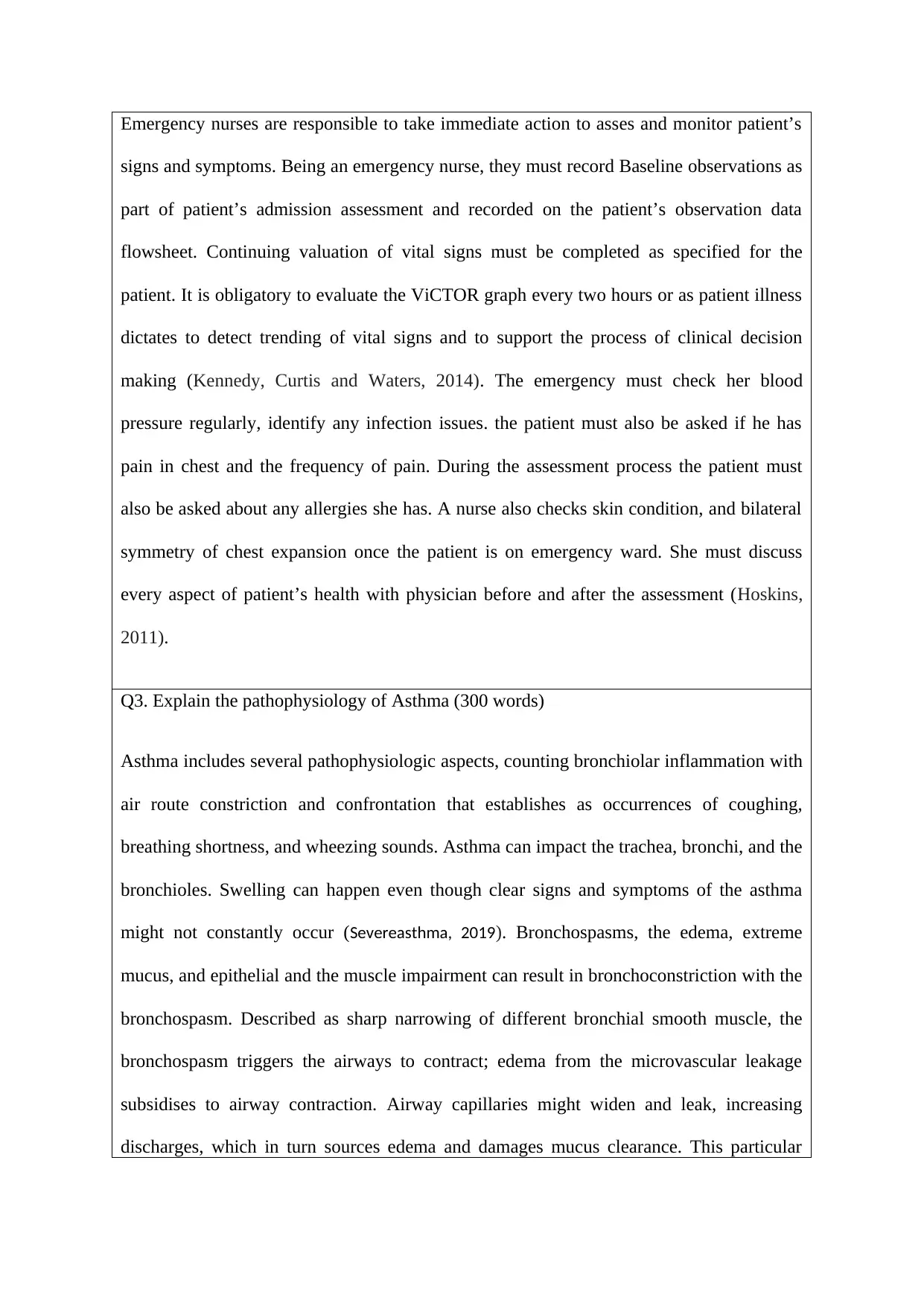
Emergency nurses are responsible to take immediate action to asses and monitor patient’s
signs and symptoms. Being an emergency nurse, they must record Baseline observations as
part of patient’s admission assessment and recorded on the patient’s observation data
flowsheet. Continuing valuation of vital signs must be completed as specified for the
patient. It is obligatory to evaluate the ViCTOR graph every two hours or as patient illness
dictates to detect trending of vital signs and to support the process of clinical decision
making (Kennedy, Curtis and Waters, 2014). The emergency must check her blood
pressure regularly, identify any infection issues. the patient must also be asked if he has
pain in chest and the frequency of pain. During the assessment process the patient must
also be asked about any allergies she has. A nurse also checks skin condition, and bilateral
symmetry of chest expansion once the patient is on emergency ward. She must discuss
every aspect of patient’s health with physician before and after the assessment (Hoskins,
2011).
Q3. Explain the pathophysiology of Asthma (300 words)
Asthma includes several pathophysiologic aspects, counting bronchiolar inflammation with
air route constriction and confrontation that establishes as occurrences of coughing,
breathing shortness, and wheezing sounds. Asthma can impact the trachea, bronchi, and the
bronchioles. Swelling can happen even though clear signs and symptoms of the asthma
might not constantly occur (Severeasthma, 2019). Bronchospasms, the edema, extreme
mucus, and epithelial and the muscle impairment can result in bronchoconstriction with the
bronchospasm. Described as sharp narrowing of different bronchial smooth muscle, the
bronchospasm triggers the airways to contract; edema from the microvascular leakage
subsidises to airway contraction. Airway capillaries might widen and leak, increasing
discharges, which in turn sources edema and damages mucus clearance. This particular
signs and symptoms. Being an emergency nurse, they must record Baseline observations as
part of patient’s admission assessment and recorded on the patient’s observation data
flowsheet. Continuing valuation of vital signs must be completed as specified for the
patient. It is obligatory to evaluate the ViCTOR graph every two hours or as patient illness
dictates to detect trending of vital signs and to support the process of clinical decision
making (Kennedy, Curtis and Waters, 2014). The emergency must check her blood
pressure regularly, identify any infection issues. the patient must also be asked if he has
pain in chest and the frequency of pain. During the assessment process the patient must
also be asked about any allergies she has. A nurse also checks skin condition, and bilateral
symmetry of chest expansion once the patient is on emergency ward. She must discuss
every aspect of patient’s health with physician before and after the assessment (Hoskins,
2011).
Q3. Explain the pathophysiology of Asthma (300 words)
Asthma includes several pathophysiologic aspects, counting bronchiolar inflammation with
air route constriction and confrontation that establishes as occurrences of coughing,
breathing shortness, and wheezing sounds. Asthma can impact the trachea, bronchi, and the
bronchioles. Swelling can happen even though clear signs and symptoms of the asthma
might not constantly occur (Severeasthma, 2019). Bronchospasms, the edema, extreme
mucus, and epithelial and the muscle impairment can result in bronchoconstriction with the
bronchospasm. Described as sharp narrowing of different bronchial smooth muscle, the
bronchospasm triggers the airways to contract; edema from the microvascular leakage
subsidises to airway contraction. Airway capillaries might widen and leak, increasing
discharges, which in turn sources edema and damages mucus clearance. This particular
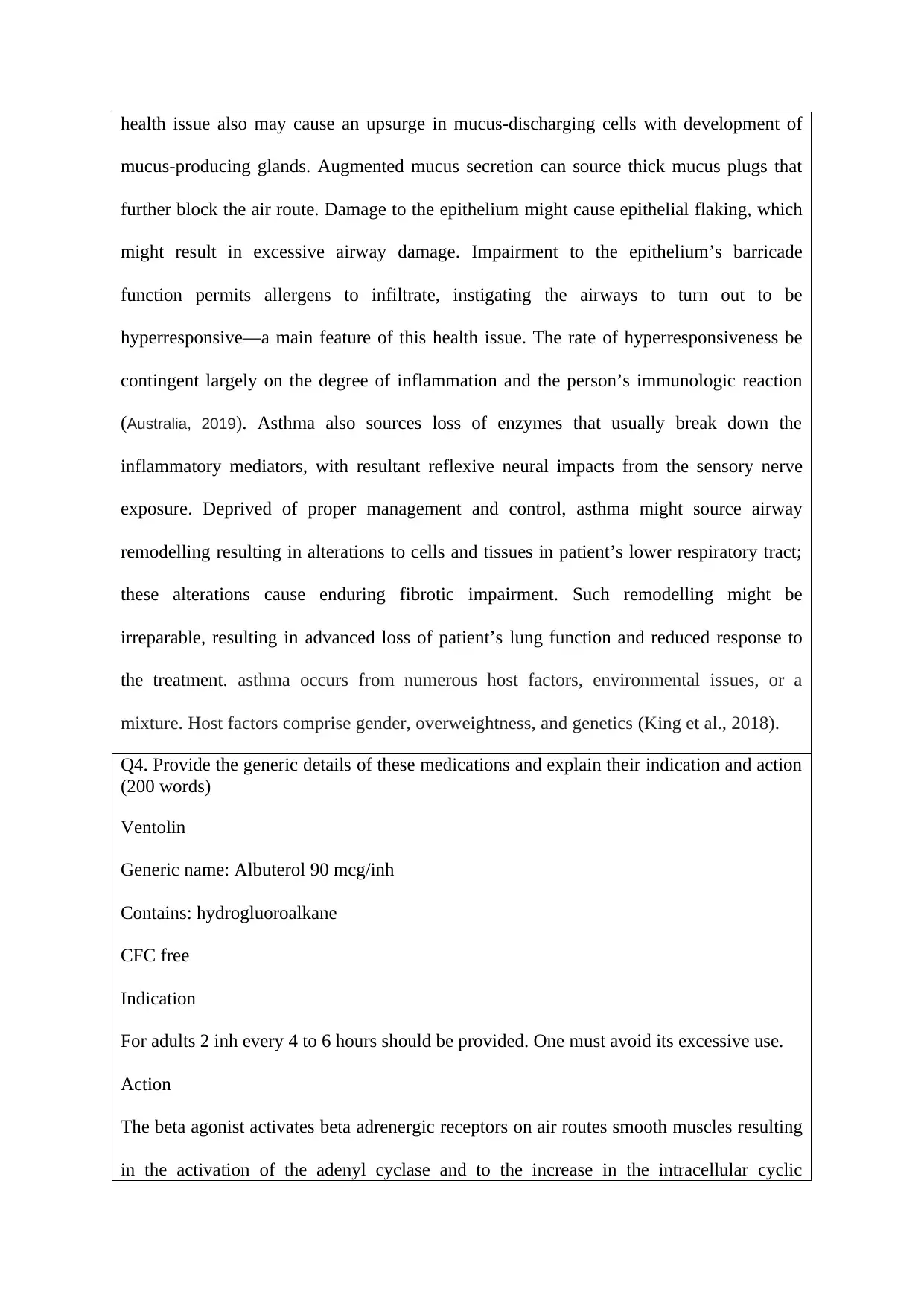
health issue also may cause an upsurge in mucus-discharging cells with development of
mucus-producing glands. Augmented mucus secretion can source thick mucus plugs that
further block the air route. Damage to the epithelium might cause epithelial flaking, which
might result in excessive airway damage. Impairment to the epithelium’s barricade
function permits allergens to infiltrate, instigating the airways to turn out to be
hyperresponsive—a main feature of this health issue. The rate of hyperresponsiveness be
contingent largely on the degree of inflammation and the person’s immunologic reaction
(Australia, 2019). Asthma also sources loss of enzymes that usually break down the
inflammatory mediators, with resultant reflexive neural impacts from the sensory nerve
exposure. Deprived of proper management and control, asthma might source airway
remodelling resulting in alterations to cells and tissues in patient’s lower respiratory tract;
these alterations cause enduring fibrotic impairment. Such remodelling might be
irreparable, resulting in advanced loss of patient’s lung function and reduced response to
the treatment. asthma occurs from numerous host factors, environmental issues, or a
mixture. Host factors comprise gender, overweightness, and genetics (King et al., 2018).
Q4. Provide the generic details of these medications and explain their indication and action
(200 words)
Ventolin
Generic name: Albuterol 90 mcg/inh
Contains: hydrogluoroalkane
CFC free
Indication
For adults 2 inh every 4 to 6 hours should be provided. One must avoid its excessive use.
Action
The beta agonist activates beta adrenergic receptors on air routes smooth muscles resulting
in the activation of the adenyl cyclase and to the increase in the intracellular cyclic
mucus-producing glands. Augmented mucus secretion can source thick mucus plugs that
further block the air route. Damage to the epithelium might cause epithelial flaking, which
might result in excessive airway damage. Impairment to the epithelium’s barricade
function permits allergens to infiltrate, instigating the airways to turn out to be
hyperresponsive—a main feature of this health issue. The rate of hyperresponsiveness be
contingent largely on the degree of inflammation and the person’s immunologic reaction
(Australia, 2019). Asthma also sources loss of enzymes that usually break down the
inflammatory mediators, with resultant reflexive neural impacts from the sensory nerve
exposure. Deprived of proper management and control, asthma might source airway
remodelling resulting in alterations to cells and tissues in patient’s lower respiratory tract;
these alterations cause enduring fibrotic impairment. Such remodelling might be
irreparable, resulting in advanced loss of patient’s lung function and reduced response to
the treatment. asthma occurs from numerous host factors, environmental issues, or a
mixture. Host factors comprise gender, overweightness, and genetics (King et al., 2018).
Q4. Provide the generic details of these medications and explain their indication and action
(200 words)
Ventolin
Generic name: Albuterol 90 mcg/inh
Contains: hydrogluoroalkane
CFC free
Indication
For adults 2 inh every 4 to 6 hours should be provided. One must avoid its excessive use.
Action
The beta agonist activates beta adrenergic receptors on air routes smooth muscles resulting
in the activation of the adenyl cyclase and to the increase in the intracellular cyclic
⊘ This is a preview!⊘
Do you want full access?
Subscribe today to unlock all pages.

Trusted by 1+ million students worldwide
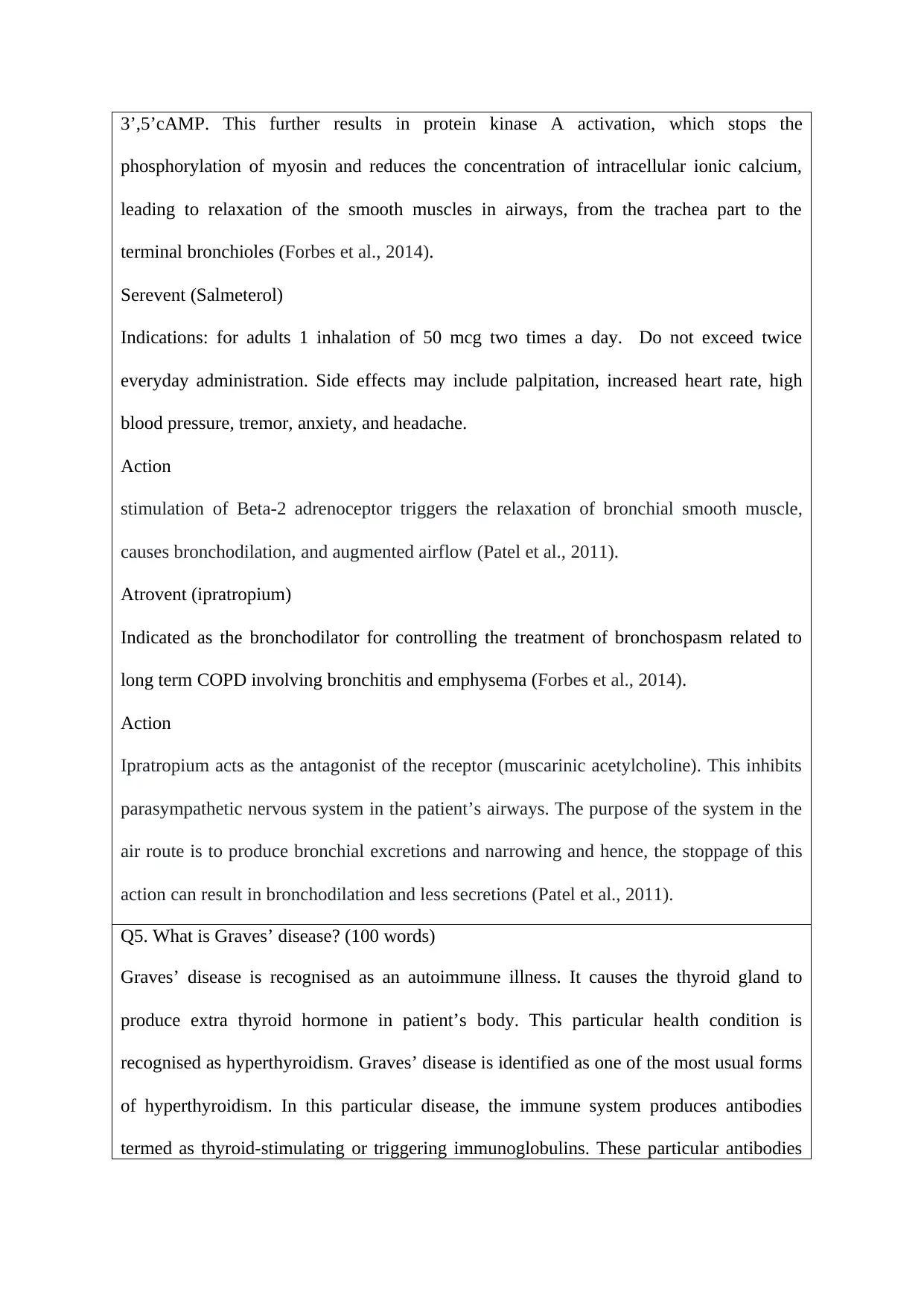
3’,5’cAMP. This further results in protein kinase A activation, which stops the
phosphorylation of myosin and reduces the concentration of intracellular ionic calcium,
leading to relaxation of the smooth muscles in airways, from the trachea part to the
terminal bronchioles (Forbes et al., 2014).
Serevent (Salmeterol)
Indications: for adults 1 inhalation of 50 mcg two times a day. Do not exceed twice
everyday administration. Side effects may include palpitation, increased heart rate, high
blood pressure, tremor, anxiety, and headache.
Action
stimulation of Beta-2 adrenoceptor triggers the relaxation of bronchial smooth muscle,
causes bronchodilation, and augmented airflow (Patel et al., 2011).
Atrovent (ipratropium)
Indicated as the bronchodilator for controlling the treatment of bronchospasm related to
long term COPD involving bronchitis and emphysema (Forbes et al., 2014).
Action
Ipratropium acts as the antagonist of the receptor (muscarinic acetylcholine). This inhibits
parasympathetic nervous system in the patient’s airways. The purpose of the system in the
air route is to produce bronchial excretions and narrowing and hence, the stoppage of this
action can result in bronchodilation and less secretions (Patel et al., 2011).
Q5. What is Graves’ disease? (100 words)
Graves’ disease is recognised as an autoimmune illness. It causes the thyroid gland to
produce extra thyroid hormone in patient’s body. This particular health condition is
recognised as hyperthyroidism. Graves’ disease is identified as one of the most usual forms
of hyperthyroidism. In this particular disease, the immune system produces antibodies
termed as thyroid-stimulating or triggering immunoglobulins. These particular antibodies
phosphorylation of myosin and reduces the concentration of intracellular ionic calcium,
leading to relaxation of the smooth muscles in airways, from the trachea part to the
terminal bronchioles (Forbes et al., 2014).
Serevent (Salmeterol)
Indications: for adults 1 inhalation of 50 mcg two times a day. Do not exceed twice
everyday administration. Side effects may include palpitation, increased heart rate, high
blood pressure, tremor, anxiety, and headache.
Action
stimulation of Beta-2 adrenoceptor triggers the relaxation of bronchial smooth muscle,
causes bronchodilation, and augmented airflow (Patel et al., 2011).
Atrovent (ipratropium)
Indicated as the bronchodilator for controlling the treatment of bronchospasm related to
long term COPD involving bronchitis and emphysema (Forbes et al., 2014).
Action
Ipratropium acts as the antagonist of the receptor (muscarinic acetylcholine). This inhibits
parasympathetic nervous system in the patient’s airways. The purpose of the system in the
air route is to produce bronchial excretions and narrowing and hence, the stoppage of this
action can result in bronchodilation and less secretions (Patel et al., 2011).
Q5. What is Graves’ disease? (100 words)
Graves’ disease is recognised as an autoimmune illness. It causes the thyroid gland to
produce extra thyroid hormone in patient’s body. This particular health condition is
recognised as hyperthyroidism. Graves’ disease is identified as one of the most usual forms
of hyperthyroidism. In this particular disease, the immune system produces antibodies
termed as thyroid-stimulating or triggering immunoglobulins. These particular antibodies
Paraphrase This Document
Need a fresh take? Get an instant paraphrase of this document with our AI Paraphraser

formerly attach to the unaffected thyroid cells. They can trigger the thyroid to produce
excessive thyroid hormone. This hormone affects numerous aspects of the body. These can
comprise the nervous system purpose, development of brain, body temperature, and other
significant elements (SBS, 2019).
Q6. Describe antithyroid drug treatment for Graves’ disease (150 words)
Antithyroid medications are drugs that either reduces synthesis of thyroid hormone
(thionamides) or release of thyroid hormone (iodides). Anti-thyroid medicines inhibit the
thyroid's usage of iodine to secrete hormones. Methimazole and the propylthiouracil (PTU)
are generic medicines that inhibit the thyroid gland’s capability to produce hormones.
Though effective in releasing symptoms within a limited week, hyperthyroidism might
return after the medication is stopped (Marinò et al., 2014). Likely adverse effects that
might mean patient is allergic to this type of medication and experience skin rash, itching,
and hives. Beta blocker medicines do not hinder the creation of thyroid hormones,
nonetheless they do inhibit the hormones effect on the body. They might be used to deliver
release of unbalanced heartbeats, tremors, nervousness or irritability, heat intolerance,
upset stomach, and weakness of muscle. Beta-blockers usually used comprise propranolol,
atenolol, the metoprolol, lopressor, and the nadolol. Since beta-blockers might complicate
asthma and diabetes management, those patients must use these medications with caution
(Betterhealth, 2018).
Q7. Explain the rationale for this combination of drug therapy and discuss the interactions
with the bronchodilators already used (200 words).
Antithyroid drugs for example methimazole (Tapazole), can be used in the combination
with the beta blocker for Jolene. After the patient begin treatment, it might take few
months for managing hyperthyroid symptoms. Patient with Graves’ disease have
augmented sensitivity to the adrenaline, and along with augmented thyroid hormone in the
excessive thyroid hormone. This hormone affects numerous aspects of the body. These can
comprise the nervous system purpose, development of brain, body temperature, and other
significant elements (SBS, 2019).
Q6. Describe antithyroid drug treatment for Graves’ disease (150 words)
Antithyroid medications are drugs that either reduces synthesis of thyroid hormone
(thionamides) or release of thyroid hormone (iodides). Anti-thyroid medicines inhibit the
thyroid's usage of iodine to secrete hormones. Methimazole and the propylthiouracil (PTU)
are generic medicines that inhibit the thyroid gland’s capability to produce hormones.
Though effective in releasing symptoms within a limited week, hyperthyroidism might
return after the medication is stopped (Marinò et al., 2014). Likely adverse effects that
might mean patient is allergic to this type of medication and experience skin rash, itching,
and hives. Beta blocker medicines do not hinder the creation of thyroid hormones,
nonetheless they do inhibit the hormones effect on the body. They might be used to deliver
release of unbalanced heartbeats, tremors, nervousness or irritability, heat intolerance,
upset stomach, and weakness of muscle. Beta-blockers usually used comprise propranolol,
atenolol, the metoprolol, lopressor, and the nadolol. Since beta-blockers might complicate
asthma and diabetes management, those patients must use these medications with caution
(Betterhealth, 2018).
Q7. Explain the rationale for this combination of drug therapy and discuss the interactions
with the bronchodilators already used (200 words).
Antithyroid drugs for example methimazole (Tapazole), can be used in the combination
with the beta blocker for Jolene. After the patient begin treatment, it might take few
months for managing hyperthyroid symptoms. Patient with Graves’ disease have
augmented sensitivity to the adrenaline, and along with augmented thyroid hormone in the

blood, this causes fast heartbeat, sweating, tremor, anxiety, augmented appetite, weight
loss, and intolerance to heat. β-blockers support to lessen these symptoms when provided
along with antithyroid medications in a determination to make the diseased person more
comfortable though expecting return to usual thyroid function (Ma, Styles and Wall, 2013).
It must be noticed that propranolol and other different β-blockers do not have significant
antithyroid effects. Though, they can trigger a slight reduction in the alteration of the main
thyroid hormone, thyroxine (T4) to its biologically active type triiodothyronine. The
combination may block the pulmonary action of Serevent. May interact with and cause
blurred vision Atrovent (Elston, 2014).
Q8. How would you respond to Jolene? What advice would you give her about her existing
condition and drug therapy related to pregnancy? Write your response as if you were
speaking to Jolene. That is in clinical conversation language instead of academic language.
Consider your professional codes and standards when writing your response (200 words).
As Jolene is experiencing different symptoms like increased heartrate, palpitations,
breathing shortness, anxiety, and headache she must be dealt empathy and respect. The
nurse must develop a therapeutic relationship with the patient and his husband and use
effective communication skills to advise her about her condition. The nurse must provide
complete information to her regarding her assessment and treatment. She must also be
included in the decision-making process (Forehan, 2012). As the drug therapy may cause
multiple side effects especially in pregnancy, she must be informed about the side effects
and must be advices to avoid overuse of these drugs. She must be advice to takes these
drugs on time and according to the prescriptions of the physician. the patient must be
advised to visit the health care setting to check thyroid levels regularly. It has been reported
that with healthy and exercise, the symptoms of asthma and graves’ disease can be
managed at some level. Thus, the patient must be informed to include some fruits in her
diet such as berries, dairy products, cruciferous vegetables, fruits containing vitamin D, and
loss, and intolerance to heat. β-blockers support to lessen these symptoms when provided
along with antithyroid medications in a determination to make the diseased person more
comfortable though expecting return to usual thyroid function (Ma, Styles and Wall, 2013).
It must be noticed that propranolol and other different β-blockers do not have significant
antithyroid effects. Though, they can trigger a slight reduction in the alteration of the main
thyroid hormone, thyroxine (T4) to its biologically active type triiodothyronine. The
combination may block the pulmonary action of Serevent. May interact with and cause
blurred vision Atrovent (Elston, 2014).
Q8. How would you respond to Jolene? What advice would you give her about her existing
condition and drug therapy related to pregnancy? Write your response as if you were
speaking to Jolene. That is in clinical conversation language instead of academic language.
Consider your professional codes and standards when writing your response (200 words).
As Jolene is experiencing different symptoms like increased heartrate, palpitations,
breathing shortness, anxiety, and headache she must be dealt empathy and respect. The
nurse must develop a therapeutic relationship with the patient and his husband and use
effective communication skills to advise her about her condition. The nurse must provide
complete information to her regarding her assessment and treatment. She must also be
included in the decision-making process (Forehan, 2012). As the drug therapy may cause
multiple side effects especially in pregnancy, she must be informed about the side effects
and must be advices to avoid overuse of these drugs. She must be advice to takes these
drugs on time and according to the prescriptions of the physician. the patient must be
advised to visit the health care setting to check thyroid levels regularly. It has been reported
that with healthy and exercise, the symptoms of asthma and graves’ disease can be
managed at some level. Thus, the patient must be informed to include some fruits in her
diet such as berries, dairy products, cruciferous vegetables, fruits containing vitamin D, and
⊘ This is a preview!⊘
Do you want full access?
Subscribe today to unlock all pages.

Trusted by 1+ million students worldwide

protein. She must perform exercises as advised by the physiotherapist (Burch et al., 2012).
Paraphrase This Document
Need a fresh take? Get an instant paraphrase of this document with our AI Paraphraser
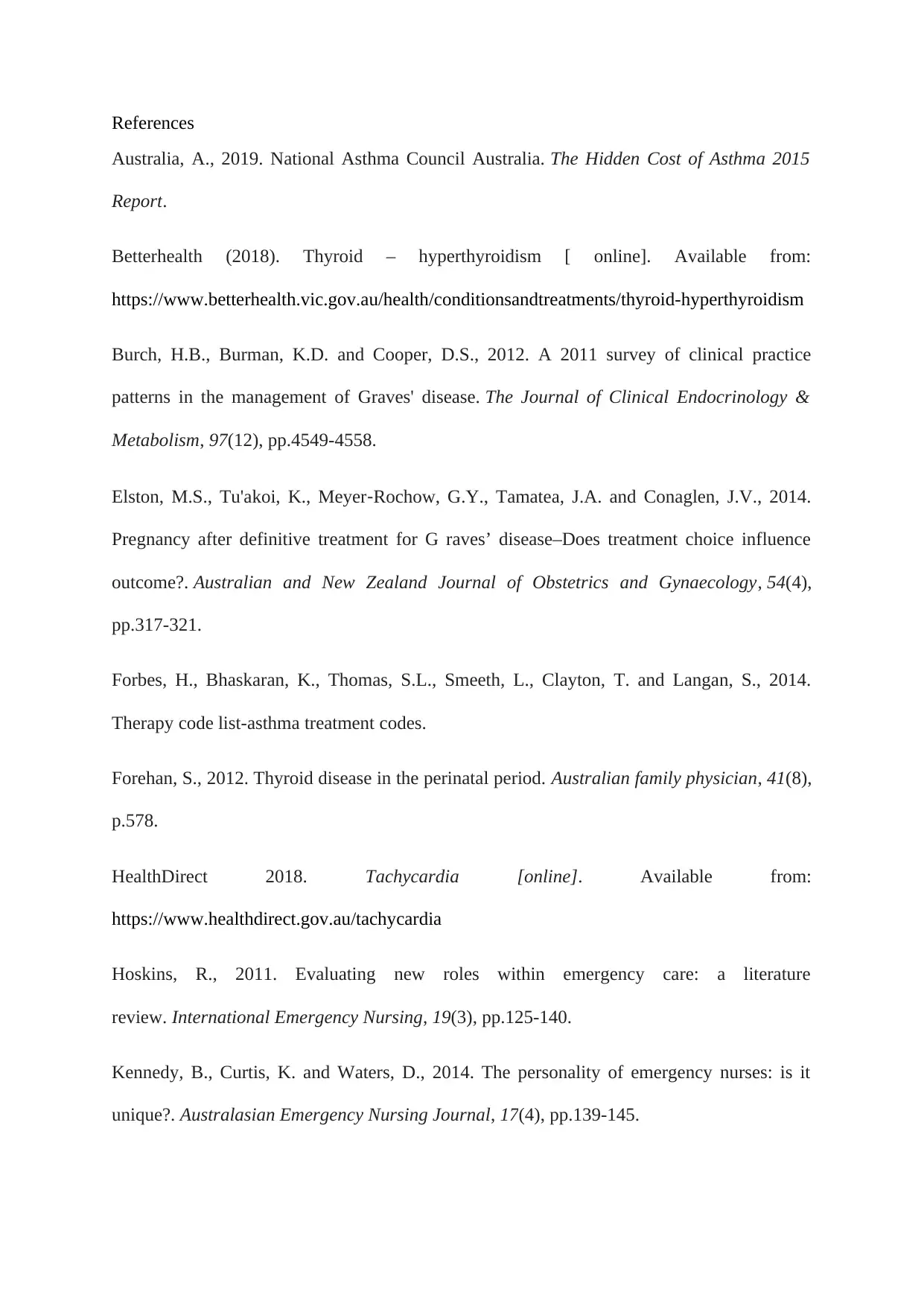
References
Australia, A., 2019. National Asthma Council Australia. The Hidden Cost of Asthma 2015
Report.
Betterhealth (2018). Thyroid – hyperthyroidism [ online]. Available from:
https://www.betterhealth.vic.gov.au/health/conditionsandtreatments/thyroid-hyperthyroidism
Burch, H.B., Burman, K.D. and Cooper, D.S., 2012. A 2011 survey of clinical practice
patterns in the management of Graves' disease. The Journal of Clinical Endocrinology &
Metabolism, 97(12), pp.4549-4558.
Elston, M.S., Tu'akoi, K., Meyer‐Rochow, G.Y., Tamatea, J.A. and Conaglen, J.V., 2014.
Pregnancy after definitive treatment for G raves’ disease–Does treatment choice influence
outcome?. Australian and New Zealand Journal of Obstetrics and Gynaecology, 54(4),
pp.317-321.
Forbes, H., Bhaskaran, K., Thomas, S.L., Smeeth, L., Clayton, T. and Langan, S., 2014.
Therapy code list-asthma treatment codes.
Forehan, S., 2012. Thyroid disease in the perinatal period. Australian family physician, 41(8),
p.578.
HealthDirect 2018. Tachycardia [online]. Available from:
https://www.healthdirect.gov.au/tachycardia
Hoskins, R., 2011. Evaluating new roles within emergency care: a literature
review. International Emergency Nursing, 19(3), pp.125-140.
Kennedy, B., Curtis, K. and Waters, D., 2014. The personality of emergency nurses: is it
unique?. Australasian Emergency Nursing Journal, 17(4), pp.139-145.
Australia, A., 2019. National Asthma Council Australia. The Hidden Cost of Asthma 2015
Report.
Betterhealth (2018). Thyroid – hyperthyroidism [ online]. Available from:
https://www.betterhealth.vic.gov.au/health/conditionsandtreatments/thyroid-hyperthyroidism
Burch, H.B., Burman, K.D. and Cooper, D.S., 2012. A 2011 survey of clinical practice
patterns in the management of Graves' disease. The Journal of Clinical Endocrinology &
Metabolism, 97(12), pp.4549-4558.
Elston, M.S., Tu'akoi, K., Meyer‐Rochow, G.Y., Tamatea, J.A. and Conaglen, J.V., 2014.
Pregnancy after definitive treatment for G raves’ disease–Does treatment choice influence
outcome?. Australian and New Zealand Journal of Obstetrics and Gynaecology, 54(4),
pp.317-321.
Forbes, H., Bhaskaran, K., Thomas, S.L., Smeeth, L., Clayton, T. and Langan, S., 2014.
Therapy code list-asthma treatment codes.
Forehan, S., 2012. Thyroid disease in the perinatal period. Australian family physician, 41(8),
p.578.
HealthDirect 2018. Tachycardia [online]. Available from:
https://www.healthdirect.gov.au/tachycardia
Hoskins, R., 2011. Evaluating new roles within emergency care: a literature
review. International Emergency Nursing, 19(3), pp.125-140.
Kennedy, B., Curtis, K. and Waters, D., 2014. The personality of emergency nurses: is it
unique?. Australasian Emergency Nursing Journal, 17(4), pp.139-145.
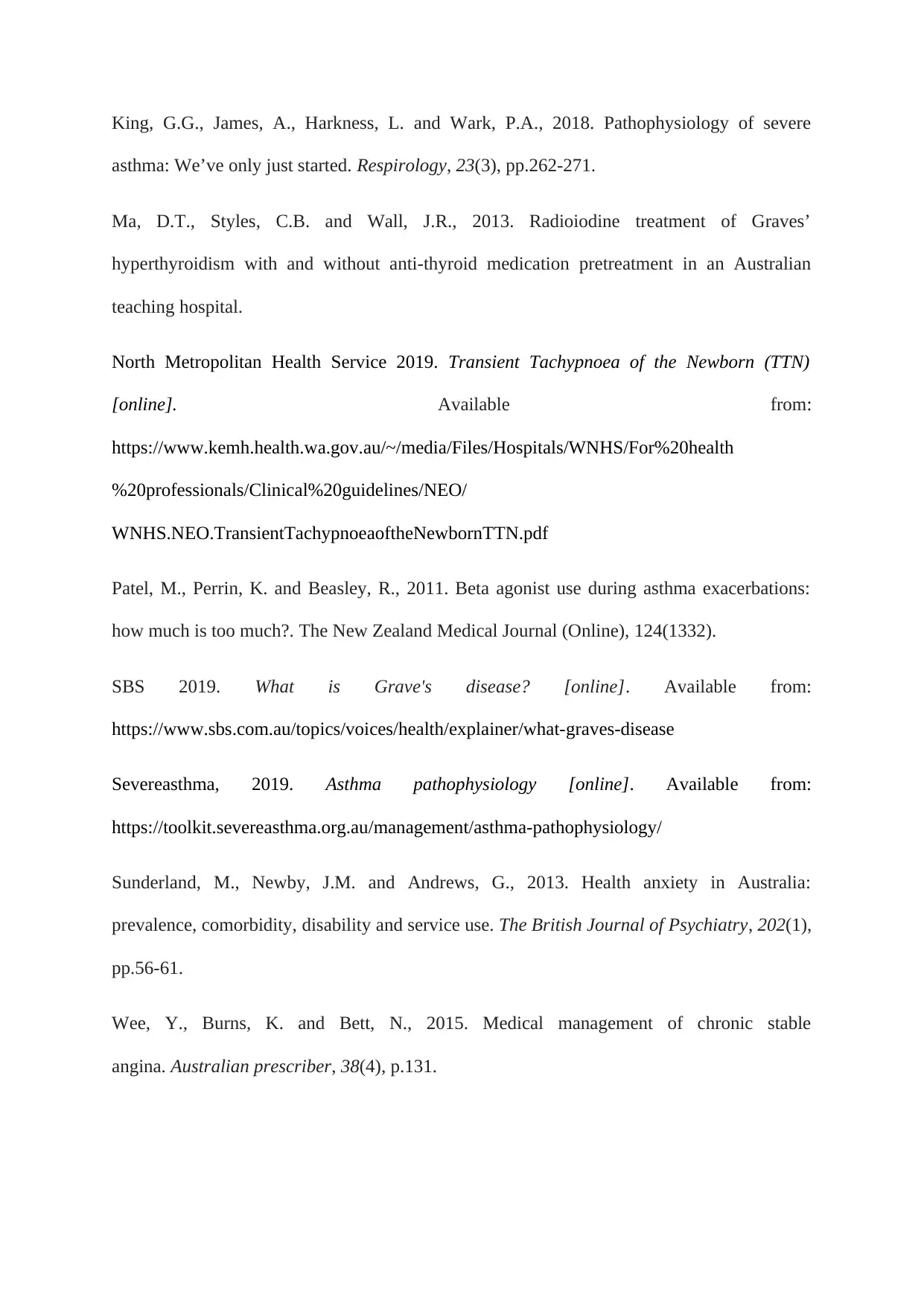
King, G.G., James, A., Harkness, L. and Wark, P.A., 2018. Pathophysiology of severe
asthma: We’ve only just started. Respirology, 23(3), pp.262-271.
Ma, D.T., Styles, C.B. and Wall, J.R., 2013. Radioiodine treatment of Graves’
hyperthyroidism with and without anti-thyroid medication pretreatment in an Australian
teaching hospital.
North Metropolitan Health Service 2019. Transient Tachypnoea of the Newborn (TTN)
[online]. Available from:
https://www.kemh.health.wa.gov.au/~/media/Files/Hospitals/WNHS/For%20health
%20professionals/Clinical%20guidelines/NEO/
WNHS.NEO.TransientTachypnoeaoftheNewbornTTN.pdf
Patel, M., Perrin, K. and Beasley, R., 2011. Beta agonist use during asthma exacerbations:
how much is too much?. The New Zealand Medical Journal (Online), 124(1332).
SBS 2019. What is Grave's disease? [online]. Available from:
https://www.sbs.com.au/topics/voices/health/explainer/what-graves-disease
Severeasthma, 2019. Asthma pathophysiology [online]. Available from:
https://toolkit.severeasthma.org.au/management/asthma-pathophysiology/
Sunderland, M., Newby, J.M. and Andrews, G., 2013. Health anxiety in Australia:
prevalence, comorbidity, disability and service use. The British Journal of Psychiatry, 202(1),
pp.56-61.
Wee, Y., Burns, K. and Bett, N., 2015. Medical management of chronic stable
angina. Australian prescriber, 38(4), p.131.
asthma: We’ve only just started. Respirology, 23(3), pp.262-271.
Ma, D.T., Styles, C.B. and Wall, J.R., 2013. Radioiodine treatment of Graves’
hyperthyroidism with and without anti-thyroid medication pretreatment in an Australian
teaching hospital.
North Metropolitan Health Service 2019. Transient Tachypnoea of the Newborn (TTN)
[online]. Available from:
https://www.kemh.health.wa.gov.au/~/media/Files/Hospitals/WNHS/For%20health
%20professionals/Clinical%20guidelines/NEO/
WNHS.NEO.TransientTachypnoeaoftheNewbornTTN.pdf
Patel, M., Perrin, K. and Beasley, R., 2011. Beta agonist use during asthma exacerbations:
how much is too much?. The New Zealand Medical Journal (Online), 124(1332).
SBS 2019. What is Grave's disease? [online]. Available from:
https://www.sbs.com.au/topics/voices/health/explainer/what-graves-disease
Severeasthma, 2019. Asthma pathophysiology [online]. Available from:
https://toolkit.severeasthma.org.au/management/asthma-pathophysiology/
Sunderland, M., Newby, J.M. and Andrews, G., 2013. Health anxiety in Australia:
prevalence, comorbidity, disability and service use. The British Journal of Psychiatry, 202(1),
pp.56-61.
Wee, Y., Burns, K. and Bett, N., 2015. Medical management of chronic stable
angina. Australian prescriber, 38(4), p.131.
⊘ This is a preview!⊘
Do you want full access?
Subscribe today to unlock all pages.

Trusted by 1+ million students worldwide

1 out of 10
Related Documents
Your All-in-One AI-Powered Toolkit for Academic Success.
+13062052269
info@desklib.com
Available 24*7 on WhatsApp / Email
![[object Object]](/_next/static/media/star-bottom.7253800d.svg)
Unlock your academic potential
Copyright © 2020–2025 A2Z Services. All Rights Reserved. Developed and managed by ZUCOL.





